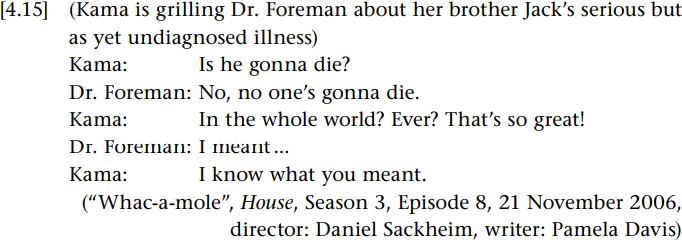

Grammar


Tenses


Present

Present Simple

Present Continuous

Present Perfect

Present Perfect Continuous


Past

Past Simple

Past Continuous

Past Perfect

Past Perfect Continuous


Future

Future Simple

Future Continuous

Future Perfect

Future Perfect Continuous


Parts Of Speech


Nouns

Countable and uncountable nouns

Verbal nouns

Singular and Plural nouns

Proper nouns

Nouns gender

Nouns definition

Concrete nouns

Abstract nouns

Common nouns

Collective nouns

Definition Of Nouns

Animate and Inanimate nouns

Nouns


Verbs

Stative and dynamic verbs

Finite and nonfinite verbs

To be verbs

Transitive and intransitive verbs

Auxiliary verbs

Modal verbs

Regular and irregular verbs

Action verbs

Verbs


Adverbs

Relative adverbs

Interrogative adverbs

Adverbs of time

Adverbs of place

Adverbs of reason

Adverbs of quantity

Adverbs of manner

Adverbs of frequency

Adverbs of affirmation

Adverbs


Adjectives

Quantitative adjective

Proper adjective

Possessive adjective

Numeral adjective

Interrogative adjective

Distributive adjective

Descriptive adjective

Demonstrative adjective


Pronouns

Subject pronoun

Relative pronoun

Reflexive pronoun

Reciprocal pronoun

Possessive pronoun

Personal pronoun

Interrogative pronoun

Indefinite pronoun

Emphatic pronoun

Distributive pronoun

Demonstrative pronoun

Pronouns


Pre Position


Preposition by function

Time preposition

Reason preposition

Possession preposition

Place preposition

Phrases preposition

Origin preposition

Measure preposition

Direction preposition

Contrast preposition

Agent preposition


Preposition by construction

Simple preposition

Phrase preposition

Double preposition

Compound preposition

prepositions


Conjunctions

Subordinating conjunction

Correlative conjunction

Coordinating conjunction

Conjunctive adverbs

conjunctions


Interjections

Express calling interjection

Phrases

Sentences


Grammar Rules

Passive and Active

Preference

Requests and offers

wishes

Be used to

Some and any

Could have done

Describing people

Giving advices

Possession

Comparative and superlative

Giving Reason

Making Suggestions

Apologizing

Forming questions

Since and for

Directions

Obligation

Adverbials

invitation

Articles

Imaginary condition

Zero conditional

First conditional

Second conditional

Third conditional

Reported speech

Demonstratives

Determiners


Linguistics

Phonetics

Phonology

Linguistics fields

Syntax

Morphology

Semantics

pragmatics

History

Writing

Grammar

Phonetics and Phonology

Semiotics


Reading Comprehension

Elementary

Intermediate

Advanced


Teaching Methods

Teaching Strategies

Assessment
Linguistic under-determinacy and what is literally said
المؤلف:
Jonathan Culpeper and Michael Haugh
المصدر:
Pragmatics and the English Language
الجزء والصفحة:
103-4
9-5-2022
763
Linguistic under-determinacy and what is literally said
One of the key challenges facing neo-Gricean accounts of speaker meaning concerns Grice’s stipulation that what is said should be constrained by the particular elements of a sentence, including their order and syntactic character. These accounts argue that this is too strict, because what speakers are taken to say2 is under-determined by linguistic forms. In other words, “filling in the boxes” provided by the words and syntactic structure through disambiguating sense, assigning reference, and resolving indexicals of the utterance via inference does not match with what we would generally understand a speaker to be saying2. Linguistic under-determinacy is thus a critical problem because we normally understand what is said2 to have both logical properties (i.e. it can enter into entailment or contradiction relations) and truth conditional properties (i.e. it can be evaluated against real world relations). And yet, without such logical and truth-conditional properties it is difficult to maintain a distinction between what is said and what is implicated.
While this issue is still being debated amongst neo-Griceans, most have opted to defend a strictly literal notion of what is said, which is then supplemented with further levels of pragmatic meaning representations.4 It is argued that a strictly literal notion of what is said is necessary in order to maintain the intuition of ordinary users that a literal meaning representation that is tightly aligned with what is said1 is potentially available, even though we might not access it in normal circumstances (Bach 2001; Terkourafi 2010). Bach (2001: 17), for instance, proposes the Syntactic Correlation constraint, namely, “that every element of what is said correspond to some element of the uttered sentence”. Notably, a literal notion of what is said is even more restricted than the definition of saying originally proposed by Grice, as it does not include reference assignment, unless it can be worked out from readily contextual information independent of the speaker’s intentions. This pared down notion of what is said might be termed “what is literally said” in order to contrast it with the more or less enriched notion of Grice (and Levinson 2000).
Work on courtroom interactions (Mosegaard-Hansen 2008), as well as observations about political doublespeak and lying (Horn 2009), suggest that speakers can indeed retreat to the literal meaning of their utterances if challenged. Consider the following example from the television series House (adapted from Horn 2009: 27):

Here Kama deliberately takes Dr. Foreman’s utterance No one’s gonna die literally in order to express irony, and perhaps also to express her worry and frustration about not knowing what is wrong with her brother.
Whether this retreat to a literal notion of what is said is regarded as legitimate or plausible in each case it occurs is a separate matter. What concerns us here is this shows us that such meaning representations are potentially available to users, and so it constitutes another layer of meaning representation that any theory must account for.
 الاكثر قراءة في pragmatics
الاكثر قراءة في pragmatics
 اخر الاخبار
اخر الاخبار
اخبار العتبة العباسية المقدسة

الآخبار الصحية















 قسم الشؤون الفكرية يصدر كتاباً يوثق تاريخ السدانة في العتبة العباسية المقدسة
قسم الشؤون الفكرية يصدر كتاباً يوثق تاريخ السدانة في العتبة العباسية المقدسة "المهمة".. إصدار قصصي يوثّق القصص الفائزة في مسابقة فتوى الدفاع المقدسة للقصة القصيرة
"المهمة".. إصدار قصصي يوثّق القصص الفائزة في مسابقة فتوى الدفاع المقدسة للقصة القصيرة (نوافذ).. إصدار أدبي يوثق القصص الفائزة في مسابقة الإمام العسكري (عليه السلام)
(نوافذ).. إصدار أدبي يوثق القصص الفائزة في مسابقة الإمام العسكري (عليه السلام)


















